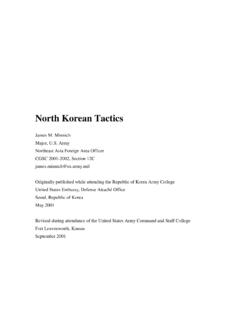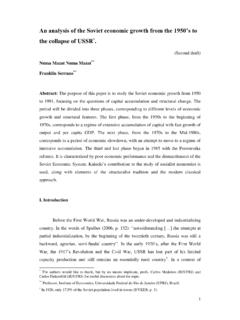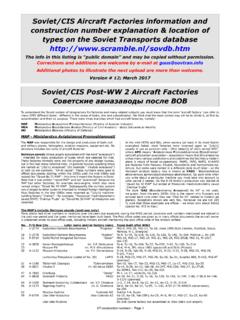Transcription of Transforming Military Diplomacy - FAOA
1 Since the collapse of the soviet Union and concur-rent with the war on ter-ror, Military attach s have been fully involved in a wide range of defense-related activities supporting national policymakers and combatant commanders. The political map has changed in the last decade, increas-ing the importance of soldier-diplo-mats serving abroad. Since 1945, the international system has expanded from 51 sovereign states to almost 200 today. Ten years ago, the United States opened new Embassies in 14 countries on the territory of the former soviet Union. Each of these newly in-dependent Eurasian states has emerged with congealing national and cultural identities, including a rediscovery of native languages long suppressed under soviet policies.
2 The fragmentation of Cold War era nation-states and the growing number of failed governments chal-lenge diplomatic missions across the globe. Anti-Americanism and radi-cal movements directed against the United States are on the rise. Even some traditional allies are no longer reliable. The Military footprint grows smaller in many regions, raising the importance of maintaining access points with countries that are receptive to policies before a crisis occurs. Combatant commanders rely heavily on the diplomatic work conducted by Embassy country teams. But a decade after the lifting of the Iron Curtain, the Department of Defense (DOD) has not adequately adjusted to the security challenges facing the attach corps and its Military -diplomatic mission.
3 This article outlines how transformation of the Military attach corps will substan-tially improve these diplomatic missions are Defense Attach Offices (DAOs), ranging in size from an estab-lished organization comprised of 14 attach s under a general/flag officer in Moscow to fledging, one-deep opera-tions headed by Army majors in some Central Asian and Caucasus countries. The DAO is the permanent DOD office assigned to diplomatic missions. Headed by the Defense Attach (DATT), it has complex command relationships with the ambassador, the combatant commander, Office of the Secretary of Defense, the Joint Staff, and the De-fense Intelligence Agency. The ambas-sador s country team is a microcosm of the interagency with representation by most Federal agencies, all under the umbrella of the Embassy.
4 The DATT represents all DOD organizations on the country team and manages com-plex command relationships with all these elements inside and outside the Embassy. In most cases, however, the attach does not have formal authority Transforming Military Diplomacy By T I M O T H Y C . S H E AColonel Timothy C. Shea, USA, is associate director of the Senior Executive Seminar for the College of International and Security Studies at the George C. Marshall European Center for Security thirty-eight / JFQ 49786th Communications Squadron (Justin D. Pyle) Defense Attach to Sierra Leone providing information for emergency evacuation of personnel in Liberia, July 2003 Forumover other elements but merely coor-dinates their activity.
5 The combatant commander has no direct link to the country teams within his area of opera-tions. This flawed arrangement misses a tremendous opportunity to enhance interagency obstacles undermine the effectiveness of Military Diplomacy , such as the prevailing view that an attach assignment does not enhance promotion prospects. Unlike many of-ficers who later became major Military figures of the First and Second World Wars, few of today s general/flag of-ficers have served as Military attach s. The relative absence of intelligence professionals with attach experience also inadvertently works to diminish the potential impact of its Military -dip-lomatic mission. The situation is analo-gous to the Special Operations Forces (SOF) community before the value of its unique capabilities, professional so-phistication, and small numbers was appreciated by the mainstream Military some 20 years transformed Military attach corps consists of three components: a new attach headquarters at the com-batant command, a fully manned DAO that handles all DOD functions and missions in-country, and an enhanced operational role for Military attach s.
6 Too much coordination at present takes place well forward in the Embassy because the interagency process is crippled at the combatant com-mand level. It occurs primarily inside the Beltway or inside the Embassy. An attach headquar-ters at the combatant command in the form of a new directorate could better reconcile guidance and policy both internally and with other Federal agencies to direct more effec-tive operations in light of the recent Unified Command Plan (UCP) change moving Russia to the European Com-mand area of responsibility, it makes good sense to reassign Military attach s directly to combatant commands. Dur-ing the Cold War, large portions of the globe were not assigned to combatant commanders, necessitating a centralized headquarters for attach s.
7 Other DOD stovepipe organizations with narrow responsibilities managing in-country se-curity assistance or arms control could be eliminated and consolidated with other duties performed by Military at-tach s. Reflagging these billets to more highly trained Military attach posi-tions will improve efficiency without a net increase in overall DOD manpower. This realignment will better accom-modate the valuable operational role of DAOs, increase attach access to host nation counterparts, raise the level of bilateral cooperation, substantially reor-der skewed mission priorities, improve information operations, and streamline the synchronization of assets in-country for improved strategic than Protocol, Alcohol, and CholesterolThe term attach has a significant and precise meaning in diplomatic usage.
8 A Military officer simply sent abroad is not an attach ; he must be accorded full diplomatic status and, as such, is afforded complete diplomatic immunity. From the beginning, the Military attach was something of a hybrid in the world of international relations. He was part diplomat, part soldier, part scout, and perhaps, as Lord George Curzon suggested, not en-tirely welcome. Military attach s were the Nation s eyes and ears abroad in the days before satellite photography and sophisticated electronic collection techniques. For example, most of the information about Axis armed forces before December 1941 came from rou-tine, tedious, and often unappreciated peacetime observations by Army atta-ch s.
9 The services sought congressional approval in September 1888 to estab-lish a number of Army and Naval atta-ch positions in Berlin, London, Paris, Rome, St. Petersburg, and Vienna. Regulations authorized wear of the ai-guillette, an item of Military ornamen-tation and the international symbol of the Military attach , in 1910. At the outbreak of war in 1914, Washington had 23 attach s assigned abroad, and they had become a regular feature of the majority of the Cold War, Secretary of Defense Robert McNamara designated T R A N S F O R M I N G M I L I T A R Y D I P L O M A C Y50 JFQ / issue thirty-eight ForumMembers of Defense Attach Corps working on psychological survival factors during computer-based training, Fairchild Air Force Base92d Communications Squadron (Lapedra Tolson)the combatant commander has no direct link to the country teams within his area of operationsa senior Military attach in each for-eign country the DATT to supervise and coordinate the work of all service attach s.
10 While every Military organi-zation requires someone in charge, the current system arbitrarily designates the DATT from the various services to particular countries. The Army and Air Attach s are often the same rank, and even though one may be vastly more qualified to serve as the DATT, princi-ples of service equities take precedence over competence. Selecting the best-qualified officer would dramatically improve the effectiveness of Military Diplomacy and ultimately force all ser-vices to develop serious foreign area officer defense attach system struc-ture, mission, and manning have not evolved with the changes of the last de-cade that require increased levels of in-volvement in operational activity. The primary attach function of observing and reporting is often considered to be in direct conflict with time and en-ergy spent on other nonintelligence activities.







